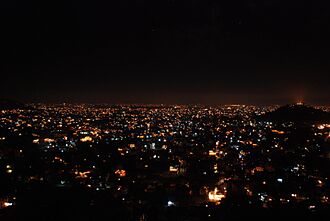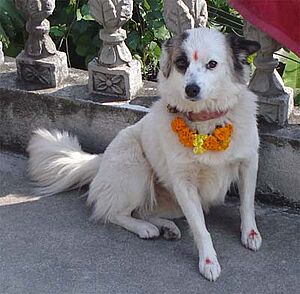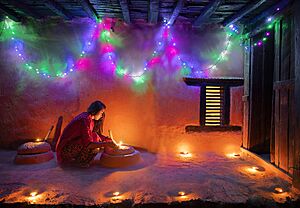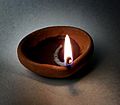Tihar (festival) facts for kids
Quick facts for kids Tihar |
|
|---|---|

Night view of the Kathmandu city during the festival (2009)
|
|
| Also called | Bhai Tika, Deepawali, Yamapanchak |
| Type | spiritual |
| Celebrations | Decorating homes with lights, gathering, worshipping, singing and dancing (Deusi Bhailo), gambling, feasts |
| Observances | Prayers and religious rituals |
| Begins | Kārtika māsa kṛṣṇa pakṣa trayodashi tithi |
| Ends | Kārtika māsa śukla pakṣa dwitiya tithi |
| 2024 date | 30th October Wednesday, to 3rd November, Sunday |
| Frequency | Annual |
| Related to | Diwali, Diwali (Jainism), Bandi Chhor Divas, Swanti, Sohrai, Bandna |
Tihar (also known as Deepawali or Yamapanchak) is a special five-day Hindu festival of lights. People in Nepal, and Indian Gorkhas in Sikkim and Gorkhaland (like Darjeeling and Kalimpong), celebrate it.
During Tihar, people light up their homes with diyo lamps, candles, and electric lights. Unlike other Diwali celebrations, Tihar also honors four animals linked to Yama, the god of death. The last day is for people themselves. The festival usually happens between October and November each year.
Contents
Celebrating Tihar
Different groups in Nepal celebrate Tihar in their own ways. For example, the Newars call it Swanti. People create beautiful patterns called Rangoli on their floors. They use colorful rice, flour, sand, or flower petals. These designs are a way to welcome gods and goddesses, especially Lakshmi, the goddess of wealth.
Homes are decorated, and lights are lit to make sure homes are bright. This is because people believe Lakshmi will not visit dark homes.
Sometimes, people set off firecrackers. However, the Nepal government has asked people not to use them because of injuries.
Children often go from house to house singing and dancing. This tradition is called Deusi or Bhailo. They receive small gifts of money or food for their performance.
Games like cards or kauda (a game with shells) are also popular during the festival. Tihar is the second biggest festival in Nepal, after Dashain. It is a national holiday for three days. It's special because it honors not only gods but also animals like crows, cows, and dogs. These animals have lived alongside humans for a long time.
Day 1: Kaag Tihar
The first day of Tihar is called Kaag (crow) Tihar. Crows and ravens are believed to be messengers of Yama, the god of death. People worship them by offering grains, seeds, and sweets on roofs or streets. In Hinduism, the sound of crows is sometimes linked to sadness. By feeding the crows, people hope to keep sadness and death away for the year.
On this day, some also celebrate Dhanteras. They honor Dhanvantari, the Hindu god of medicine. It is also a lucky day to buy jewelry, utensils, or gold and silver.
Day 2: Kukur Tihar
The second day is Kukur (dog) Tihar. On this day, all dogs, whether pets or strays, are honored. People put a special mark called a tika on their foreheads. They also place garlands of marigolds around their necks. This day celebrates the special bond between humans and dogs.
In ancient stories, dogs are seen as loyal companions. For example, in the Mahabharata, a dog is shown to be very important. Also, Bhairava, a form of Lord Shiva, has a dog as his vehicle. Yama, the god of death, is believed to have two guard dogs. These dogs watch over the gates of Naraka, which is the Hindu idea of Hell. This day is also known as Naraka Chaturdashi.
Kukur Tihar has become very popular online. In 2016, a group in Mexico City even started a similar celebration for animals.
Day 3: Gai Tihar and Lakshmi Puja
The morning of the third day is called Gai (cow) Tihar. Cows are very important and considered sacred in Hinduism. On this day, Nepali Hindus show thanks to cows. They feed them treats and worship them with tikas and garlands.
The third day is also the most important day of Tihar. Lakshmi, the goddess of wealth, is welcomed into homes. People clean their homes and decorate doorways and windows with marigold garlands. Diyos (oil lamps) are placed all around the house, especially in doorways and windows. Electric lights are also used. People believe Lakshmi will not visit dark homes. In the evening, a special puja (worship) is offered to Lakshmi. People wish for wealth, good health, and success.
In the evening, young girls go around the neighborhood. They sing and dance in a tradition called bhailo. They receive small amounts of money and food as thanks for their entertainment. Fireworks are also common on this day.
Day 4: Govardhan Puja and Mha Puja
The fourth day of Tihar is called Goru Puja. On this day, oxen are worshipped and celebrated. Oxen are important in farming countries like Nepal because they provide hard work. Vaishnav Hindus also perform Govardhan Puja. This is a worship of the holy Govardhan mountain. A pile of cow dung is sometimes used to represent the mountain and is worshipped.
This day also often marks the first day of the Nepal Sambat calendar. For the Newar community, it is a special celebration called Mha Puja. Mha Puja is a unique tradition where people worship their own self and soul.
Day 5: Bhai Tika
The fifth and last day of Tihar is called Bhai Tika. This day celebrates the special bond between brothers and sisters. They worship each other and exchange gifts to show their feelings.
A story says that Yamuna's brother became very sick. Yama, the god of death, came to take his soul. Yamuna begged Yama to wait until she finished a special puja for her brother. She performed a long ceremony that even included Yama. Then, Yamuna asked Yama not to take her brother until the tika on his forehead faded, the oil she put on him dried, and the Makhamali Ful Ko Mala (garlands made of Gomphrena globosa flowers) wilted.
So, on Bhai Tika, sisters create a protective circle around their brothers. They use holy water and blessed oil. A special garland made from the makhamali flower is placed around the brother's neck. This flower is known for lasting a long time. The tika on the brother's forehead is unique because it has seven different colors. Brothers also put a tika on their sisters' foreheads.
This ceremony is done no matter if the brother is older or younger. Cousins can also take part. At the end, brothers touch their sisters' feet with their foreheads. This shows love, respect, and devotion. Brothers receive cooked food like sel roti, fruits, and packaged food. Sisters receive money or other gifts, such as clothing.
Images for kids
See also
- Swanti, a similar festival celebrated by the Newar community of Nepal








